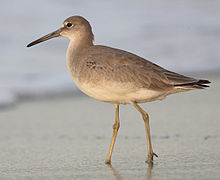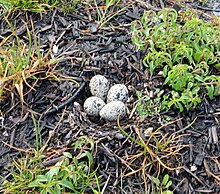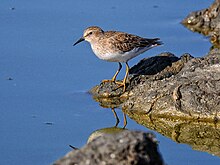Sandpiper
| Sandpipers Temporal range:Early Oligoceneto recent
| |
|---|---|

| |
| Willet(Tringa semipalmata) | |
| Scientific classification | |
| Domain: | Eukaryota |
| Kingdom: | Animalia |
| Phylum: | Chordata |
| Class: | Aves |
| Order: | Charadriiformes |
| Suborder: | Scolopaci |
| Family: | Scolopacidae Rafinesque,1815 |
| Type genus | |
| Scolopax | |
| Genera | |
Scolopacidaeis a large family ofshorebirds,or waders, which mainly includes many species known assandpipers,but also others such aswoodcocks,curlewsandsnipes.The majority of these species eat smallinvertebratespicked out of the mud or soil. Different lengths ofbillsenable different species to feed in the samehabitat,particularly on thecoast,without direct competition for food.
Sandpipers have long bodies and legs, and narrow wings. Most species have a narrow bill, but otherwise the form and length are quite variable. They are small to medium-sized birds, measuring 12 to 66 cm (4.7–26.0 in) in length. The bills are sensitive, allowing the birds to feel the mud andsandas they probe for food. They generally have dullplumage,with cryptic brown, grey, or streaked patterns, although some display brighter colours during the breeding season.[1]
Most species nest in open areas, and defend their territories with aerial displays. Thenestitself is a simple scrape in the ground, in which the bird typically lays three or foureggs.The young of most species areprecocial.[1]

Taxonomy[edit]
The family Scolopacidae was introduced (as Scolopacea) by the FrenchpolymathConstantine Samuel Rafinesquein 1815.[2][3]The family contains 98 extant or recently extinct species divided into 15genera.[4]For more details, see the articleList of sandpiper species.
The following genus level cladogram of the Scolopacidae is based on a study by David Černý and Rossy Natale that was published in 2022.[5]
| Scolopacidae |
| |||||||||||||||||||||||||||||||||||||||||||||||||||||||||||||||||||||||||||||||||
Evolution[edit]
The earlyfossilrecord is scant for a group that was probably present at the non-aviandinosaur's extinction."Totanus" teruelensis(Late MioceneofLos Mansuetos(Spain) is sometimes considered a scolopacid – maybe a shank – but may well be alarid;little is known of it.
Paractitishas been named from theEarly OligoceneofSaskatchewan(Canada), whileMiroliais known from theMiddle MioceneatDeiningenin theNördlinger Ries(Germany). Most living genera would seem to haveevolvedthroughout theOligocenetoMiocenewith thewadersperhaps a bit later; see the genus accounts for the fossil record.
In addition there are some indeterminable remains that might belong to extant genera or their extinct relatives:
- Scolopacidae gen. et sp. indet. (Middle Miocene of Františkovy Lázně, Czech Republic – Late Miocene of Kohfidisch, Austria)
- Scolopacidae gen. et sp. indet. (Edson Early Pliocene of Sherman County, USA)[note 1]
Description[edit]

The sandpipers exhibit considerable range in size and appearance, the wide range of body forms reflecting a wide range of ecological niches. Sandpipers range in size from theleast sandpiper,at as little as 18 grams (0.040 pounds) and 11 cm (4.3 in) in length, to theFar Eastern curlew,at up to 66 cm (26 in) in length, and theEurasian curlew,at up to 1.3 kg (2.9 lb). Within species there is considerable variation in patterns ofsexual dimorphism.Males are larger than females inruffsand several sandpipers, but are smaller than females in theknots,curlews,phalaropesandgodwits.The sexes are similarly sized in thesnipes,woodcockand tringine sandpipers. Compared to the other large family of wading birds, theplovers(Charadriidae), they tend to have smaller eyes, more slender heads, and longer thinner bills. Some are quite long-legged, and most species have three forward pointing toes with a smaller hind toe (the exception is thesanderling,which lacks a hind toe).[7]
Sandpipers are more geared towards tactile foraging methods than the plovers, which favour more visual foraging methods, and this is reflected in the high density of tactile receptors in the tips of theirbills.These receptors are housed in a slight horny swelling at the tip of the bill (except for thesurfbirdand the twoturnstones). Bill shape is highly variable within the family, reflecting differences in feeding ecology. Bill length relative to head length varies from three times the length of the head in thelong-billed curlewto just under half the head length in theTuamotu sandpiper.Bills may be straight, slightly upcurled or strongly downcurved.[7]Like all birds, the bills of sandpipers are capable ofcranial kinesis,literally being able to move the bones of the skull (other than the obvious movement of the lower jaw) and specifically bending the upper jaw without opening the entire jaw, an act known asrhynchokinesis.It has been hypothesized this helps when probing by allowing the bill to be partly opened with less force and improving manipulation of prey items in the substrate. Rhynchokinesis is also used by sandpipers feeding on prey in water to catch and manipulate prey.[8]
Distribution, habitat, and movements[edit]

The sandpipers have acosmopolitan distribution,occurring across most of the world's land surfaces except for Antarctica and the driest deserts. A majority of the family breed at moderate to high latitudes in theNorthern Hemisphere,in fact accounting for the most northerly breeding birds in the world. Only a few species breed in tropical regions, ten of which are snipes and woodcocks and the remaining species being the unusual Tuamotu sandpiper, which breeds inFrench Polynesia(although prior to the arrival of humans in the Pacific there were several other closely related species ofPolynesian sandpiper).[7]
Diet and feeding[edit]
There are broadly four feeding styles employed by the sandpipers, although many species are flexible and may use more than one style. The first is pecking with occasional probing, usually done by species in drier habitats that do not have soft soils or mud. The second, and most frequent, method employed is probing soft soils, muds and sands for prey. The third, used byTringashanks, involves running in shallow water with the bill under the water chasing fish, a method that uses sight as well as tactile senses. The final method, employed by the phalaropes and someCalidrissandpipers, involves pecking at the water for small prey.[7]A few species of scolopacids are omnivorous to some extent, taking seeds and shoots as well as invertebrates.
Breeding[edit]
Many sandpipers form monogamous pairs, but some sandpipers have female-only parental care, some male-only parental care, some sequential polyandry and other compete for the mate on thelek.Sandpipers lay three or four eggs into the nest, which is usually a vague depression or scrape in the open ground, scarcely lined with soft vegetation.[7]In species where both parents incubate the eggs, females and males share their incubation duties in various ways both within and between species. In some pairs, parents exchange on the nest in the morning and in the evening so that their incubation rhythm follows a 24-hour day, in others each sex may sit on the nest continuously for up to 24 hours before it is exchanged by its partner.[9]In species where only a single parent incubates the eggs, during the night the parent sits on the eggs nearly continuously and then during the warmest part of a day leaves the nest for short feeding bouts.[10]Chicks hatch after about three weeks of incubation and are able to walk and forage within a few hours of hatching. A single parent or both parents guide and brood the chicks.[7]
Gallery[edit]
-
Sandpiper -Tunisia
-
Bristle-thighed curlew(Numenius tahitiensis,right) andruddy turnstones(Arenaria interpres)
-
Common snipe(Gallinago gallinago)
-
Greenshank(Tringa nebularia)
Footnotes[edit]
- ^Adistalrighttarsometatarsusof a bird roughly similar to apectoral sandpiper.Probablycalidridor basal to them, somewhat reminiscent ofturnstones.[6]
References[edit]
- ^abHarrison, Colin J.O. (1991). Forshaw, Joseph (ed.).Encyclopaedia of Animals: Birds.London: Merehurst Press. pp. 103–105.ISBN1-85391-186-0.
- ^Rafinesque, Constantine Samuel(1815).Analyse de la nature ou, Tableau de l'univers et des corps organisés(in French). Vol. 1815. Palermo: Self-published. p. 70.
- ^Bock, Walter J. (1994).History and Nomenclature of Avian Family-Group Names.Bulletin of the American Museum of Natural History. Vol. 222. New York: American Museum of Natural History. pp. 113, 252.hdl:2246/830.
- ^Gill, Frank;Donsker, David;Rasmussen, Pamela,eds. (July 2021)."Sandpipers, snipes, coursers".IOC World Bird List Version 11.2.International Ornithologists' Union.Retrieved18 November2021.
- ^Černý, David; Natale, Rossy (2022)."Comprehensive taxon sampling and vetted fossils help clarify the time tree of shorebirds (Aves, Charadriiformes)"(PDF).Molecular Phylogenetics and Evolution.177:107620.doi:10.1016/j.ympev.2022.107620.PMID36038056.
- ^Wetmore, Alexander(1937)."The Eared Grebe and other Birds from the Pliocene of Kansas"(PDF).Condor.39(1): 40.doi:10.2307/1363487.JSTOR1363487.
- ^abcdefPiersma, Theunis (1996)."Family Scolopacidae (Snipes, Sandpipers and Phalaropes)".In del Hoyo, Josep; Elliott, Andrew; Sargatal, Jordi (eds.).Handbook of the Birds of the World. Volume 3, Hoatzin to Auks.Barcelona: Lynx Edicions. pp. 444–487.ISBN978-84-87334-20-7.
- ^Estrella, Sora; Masero, José A. (2007)."The use of distal rhynchokinesis by birds feeding in water".Journal of Experimental Biology.210(21): 3757–3762.doi:10.1242/jeb.007690.PMID17951416.
- ^Bulla, Martin; Valcu, Mihai; Dokter, Adriaan M.; Dondua, Alexei G.; Kosztolányi, András; Rutten, Anne L.; Helm, Barbara; Sandercock, Brett K.; Casler, Bruce (2016)."Unexpected diversity in socially synchronized rhythms of shorebirds"(PDF).Nature.540(7631): 109–113.Bibcode:2016Natur.540..109B.doi:10.1038/nature20563.PMID27880762.S2CID4390453.
- ^Løfaldli, Lars (1985-01-01). "Incubation Rhythm in the Great Snipe Gallinago media".Holarctic Ecology.8(2): 107–112.Bibcode:1985Ecogr...8..107L.doi:10.1111/j.1600-0587.1985.tb01160.x.JSTOR3682650.
External links[edit]
- Sandpiper mediaon the Internet Bird Collection
- Cornell Lab of Ornithology sandpiper search results
- RedKnot.orglinks to shorebird recovery sites, movies, events & other information on red knot rufa and horseshoe crabs.





